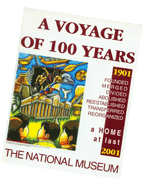ARCHAEOLOGY DIVISION

Function
Conducts systematic research and maintenance of collections on the prehistory and archaeology of the Philippines in both land and underwater archaeological sites.
Historical Notes
The creation of the Archaeology Division in 1988 marked the birth of the youngest of the twelve divisions of the National Museum. The Anthropology Division concentrated on the study of prehistoric culture, historical archeology, and the new field of underwater archeology.
The Archaeology Division is relatively young, but activities and studies in this discipline can be traced to as far back as the Spanish colonial period. As early as the l9th century, foreign archaeologists began scouring the Philippine Archipelago for evidences of early man. Scientists like Feodor Jagor, J. Montano, Paul Rey and Dean C. Worcester all made separate explorations in various parts of the country. Each one of them went home with a good collection of earthenwares, semistonewares, glazed burial jars with human skeletal remains, carved wooden coffins, ornaments of metal, shell and glass as well as wooden and metal implements and carved wooden images.
The dawn of Philippine archaeology came in the 1920s when American scientist Carl Guthe conducted his explorations in the Visayan Islands. His yield was amazing: 31 cubic tons of archaelogical specimens from 542 sites! Most of his finds are now deposited at the University of Michigan in the United States.
At about this time, a fortnightly scientific symposium was opened at the Bureau of Science under the chairmanship of Roy E. Dickerson. This symposium tackled the geological, biological and human history of the Philippines. The results were partially published in 1928 as Monograph No. 21 of the Bureau of Science entitled "Distribution of Life in the Philippines" which confirmed the country's special niche in the international scientific plane.
Philippine archaeology will not complete without the name of H. Otley Beyer who accumulated and examined about thirty neolithic implements geographically scattered from Davao to Northern Luzon. His findings show that the Philippines had a late stone-age population, though the remains scarce and widely scattered.
When Beyer chaired the Department of Anthropology at the University of the Philippines in the mid-1920s, an accidental archaeological work took place at the Novancnes Dam and Reservoir Project in Rizal Province. This yielded some 18,000 specimens of stone and metal artifacts, beads, glass and pottery bracelets, mammalian fossils and potshards.
In 1932, F.G. Roth discovered the first Batangas site in Cuenca in 1932 which contained a neolithic assemblage. With Beyer's help, the survey was extended gradually southward to the municipality of Alitagtag and by 1935, a full Stone-Age series from Early Paleolithic he latest Neolithic and Bronze Ages was found.
Turning Points
After a strong of successful search operations, Prof. Beyer carried out collection activities in other Philippine area until the outbreak of World War II. Following his footsteps, local scientists from the National Museum, Ricardo G. Galang and Generoso Maceda, similarly pursued explorations in Quezon and Sorsogon provinces in 1938. Their studies yielded burial sites and 24 burial jars from Pilar, Sorsogon.
By November 1949, Filipino students Arsenio Manuel and Alfredo Evangelista joined Wilhelm Solheim, an American graduate student, in undertaking archaeological excavations under the tutelage of Prof. Beyer. They explored the Bondoc Peninsula up to Batungan Mountain in Masbate, where they found pottery belonging to the Neolithic Period.
This triumphant partnership between Filipino and foreign researchers signalled the beginning of more joint ventures in Philippine archaeology. The most outstanding feat of the 1950s was major fieldwork of National Mumseum researchers led by Evangelista and Robert Fox who later became one he most famous foreign archaeologist who worked in the Philippines. The group undertook an archaeological excavation in Bato Caves, Sorsogon in 1956 which yielded a burial jar and stone tool assemblage with no metal remains.
A C-14 date of 2280+/- 250 BP date was obtained. The following year, Cagraray Cave Sites were explored. A similar assemblage but with the addition of Chinese porcelain and stoneware jars, was unearthed, thus challenging Beyer's earlier theory that the technology of pottery manufacture did not reach the Philippines before iron.
The most extensive archaeological project during this period was the excavation of burial sites in Calatagan, Batangas, where over 500 burials were excavated, yielding 1,135 pieces of tradeware ceramics of Chinese and Siamese origin dating back to the late l4th and early l6th centuries.
Filipino-American explorations continued up to the 1960s. The National Museum conducted major explorations in the west coast of Palawan together with Robert Fox. They found the Tabon skull cap inside Tabon Cave which was the earliest evidence of human presence in the Philippines with a C-14 date of over 16,000 years ago! Fox also helped establish four broad cultural ages in the country: the Paleolithic Age, Neolithic Age, Metal Age and the Age of Contact and Trade with the East.
Publications-wise, the most significant turning point was Beyer's "Outline Review of Philippine Archaeology by Islands and Provinces" published in the Philippine Journal of Science in 1947, followed by his "Philippine and East Asian Archaeology, and Its Relation to the Origin of the Pacific Islarids Population" published by the National Research Council of the Philippines as its Bulletin 29 in 1948. These major publications are still widely used today as references in the study of Philippine archaeology. The monograph "Tabon Caves" was published in 1970.
Archaeologists from the National Museum, such as Avelino Legaspi, Florante Henson, Wilfredo Ronquillo (now Chief of the Archaeology Division), and Eusebio Dizon, have participated in extensive research throughout the 70s in many parts of the country where
recorded. This ushered in a new era of Philippine archaeological studies where lead researchers were Filipinos.Another milestone in the history of the Archaeology Division and Philippine prehistory happened with recovery of two ancient Philippine boats called "balanghai" from Butuan, Agusan del Norte which were found to have a C-14 date of 4th and l3th-l4th centuries AD.
Towards the later part of the 80s the Underwater Archaeology section was created. Maritime archaeology in the Philippines became more active. This led to the discovery of shipwrecks from Chinese junks to galleons like the Pandanan Shipwreck in Southern Palawan, and Galleon de San Diego in Fortune Island, Batangas.
Many more interesting discoveries were made by National Museum archaeologists. These include the recovery of stone tools like flakes and cobbles, a Neolithic shell mound with artifacts like pottery, polished stone tools, clay pendants, etc. in Cagayan Valley; habitation and burial sites dating 400 years before the arrival of Spaniards in Sta. Ana, Manila; and artifacts like obsidian flakes, iron implements, pottery and tradewares in Laguna Bay area, the site of the earliest cremation in the Philippines.
The desire for more archeological breakthroughs in Philippine lands and waters continues today, as the Archaeology Division continues to fulfill its mandate.
A Broader Role
The Archaeology Division maintains an unwavering dedication to the objective of conducting archaeological researches in terrestrial and underwater sites, with a higher goal of placing Philippine archaeological finds in the world's scientific almanac. After gaining autonomy from the Anthropology Division, the 40-stron staff of the Archaeology Division faces greater challenges in Museum's campaign for research excellence.
Responding to the call of the times, the Division now conducts, Archaeological Assessment for each project in strict compliance with the existing laws on cultural and environmental protection. , Finally, extension services in the form of technical assistance, mounting of exhibits, loan of photographs and artifacts are also actively pursued.
Quest For Excellence
Following the much publicized success and euphoria of the Tabon skull cap and other discoveries, foreign institutions have developed a growing confidence level in the capability of the National Museum's Archaeology Division to pursue more projects of similar magnitude.
In addition to the scientific acclaim of its archaeological achievements in the past forty years, the Division takes much pride in the fact that two of its key people were similarly recognized. Angel P. Bautista and Miguel Accion, Jr. received the National Museum's Kapwa Award in 1992 and 1996, respectively, for their outstanding contribution to public service. Accion received the most distinguished Dangal ng Bayan Presidential Award in 1993 for his outstanding accomplishment as a public servant.
Keeping an eye on its goals and objectives, the Archaeology Division is certainly headed for more and greater challenges in the coming years.
taken from the
"A Voyage of 100 Years"



